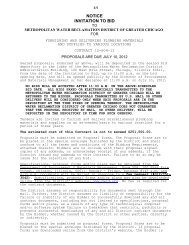Report - Metropolitan Water Reclamation District of Greater Chicago
Report - Metropolitan Water Reclamation District of Greater Chicago
Report - Metropolitan Water Reclamation District of Greater Chicago
You also want an ePaper? Increase the reach of your titles
YUMPU automatically turns print PDFs into web optimized ePapers that Google loves.
farmland. In the fall <strong>of</strong> 2004, the <strong>District</strong> began a research and demonstration project on<br />
farmers' fields in Will and Kankakee Counties to demonstrate the safety <strong>of</strong> farmland application<br />
<strong>of</strong> Class B centrifuge cake biosolids and to improve the overall public perception and the<br />
understanding <strong>of</strong> communities residing in the vicinities <strong>of</strong> biosolids-amended farmlands. The<br />
field project sites were used by the <strong>District</strong> and farmland application contractor to host field<br />
days. The data collection component <strong>of</strong> this project was concluded in 2007. During 2010,<br />
activities on this project included analysis <strong>of</strong> samples and data analysis for the project report.<br />
Fate and Transport <strong>of</strong> Biosolids-Borne Triclosan and Triclocarban. Triclosan (TCS) and<br />
triclocarban (TCC) are the active ingredients heavily used in the antibacterial product market and<br />
these compounds are discharged from industries and household drains to become influent to<br />
wastewater treatment plants. In 2008, the <strong>District</strong> began a study in collaboration with University<br />
<strong>of</strong> Florida to conduct laboratory and bench scale tests on samples <strong>of</strong> <strong>District</strong> biosolids to<br />
determine the levels <strong>of</strong> TCS and TCC in the biosolids and the fate <strong>of</strong> these compounds in<br />
biosolids amended soil. Activities conducted by the section on this project in 2010 included<br />
trapping <strong>of</strong> earthworms in biosolids amended soil for bench scale tests and hosting a project<br />
meeting.<br />
Investigation <strong>of</strong> Stabilization <strong>of</strong> Dewatered Biosolids in Lagoons. The <strong>District</strong>'s<br />
exceptional quality air-dried biosolids, which are produced by lagoon aging and air-drying, are<br />
utilized under the Controlled Solids Distribution Program in the <strong>Chicago</strong> metropolitan area on<br />
golf courses, parks, and athletic fields. The odor potential <strong>of</strong> the dried biosolids is a major factor<br />
controlling the cost <strong>of</strong> managing the biosolids, public acceptance, and the economic value <strong>of</strong> the<br />
product. In 2009, the <strong>District</strong> initiated a project to investigate mechanisms <strong>of</strong>biosolids stability<br />
and the factors controlling odor potential during processing <strong>of</strong> <strong>District</strong> air-dried biosolids. The<br />
first phase <strong>of</strong> the study was done in collaboration with the Illinois Institute <strong>of</strong> Technology and<br />
was focused on determination <strong>of</strong> indices <strong>of</strong> biosolids stability during lagoon aging. This first<br />
phase <strong>of</strong> the project was completed in 2010 and a paper reporting the results <strong>of</strong> the study has<br />
been submitted for journal publication.<br />
Effect <strong>of</strong> Moisture on Odor Potential <strong>of</strong> Biosolids During Storage. Air-dried biosolids<br />
used under the <strong>District</strong>'s Controlled Solids Distribution Program are available only during a<br />
limited period <strong>of</strong> the year, because dried biosolids typically become odorous during storage.<br />
This study began in mid-201O and is designed to determine the effect <strong>of</strong> various biosolids<br />
moisture contents on odor development in biosolids during storage. The study consists <strong>of</strong><br />
stockpiling <strong>of</strong> biosolids under cover at the HASMA and measuring the odor emission potential<br />
over time.<br />
Greenhouse Gas Accounting <strong>of</strong> the <strong>District</strong>'s Biosolids Management Program. The use<br />
<strong>of</strong> biosolids are known to directly and indirectly affect the generation <strong>of</strong> methane and nitrous<br />
oxides and soil carbon sequestration, which can be translated into carbon debits and credits in<br />
greenhouse gas accounting. In collaboration with the University <strong>of</strong> Washington, the <strong>District</strong><br />
28
















